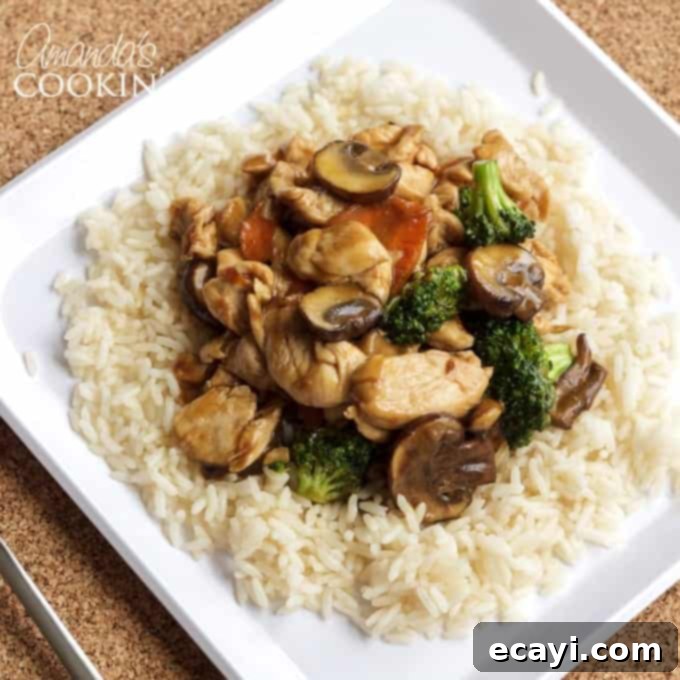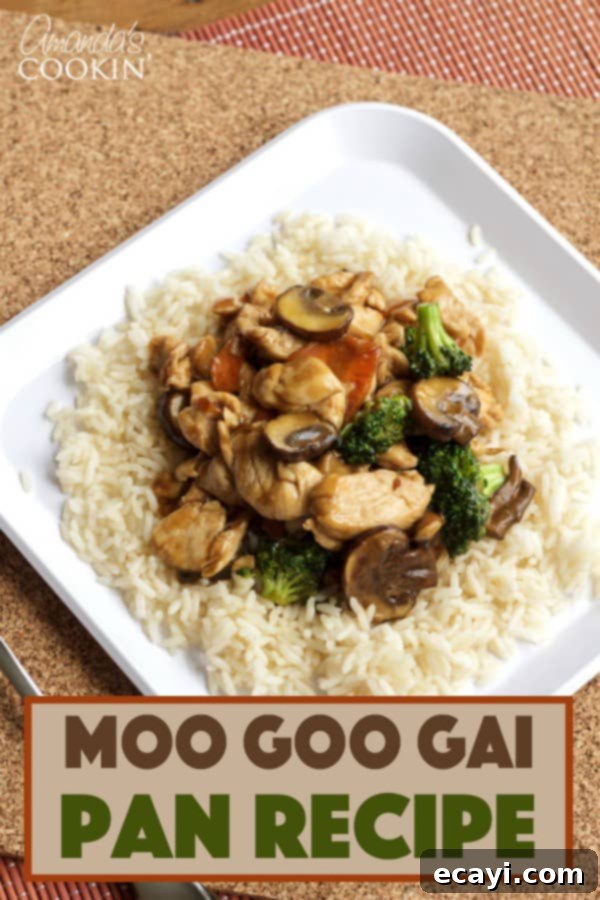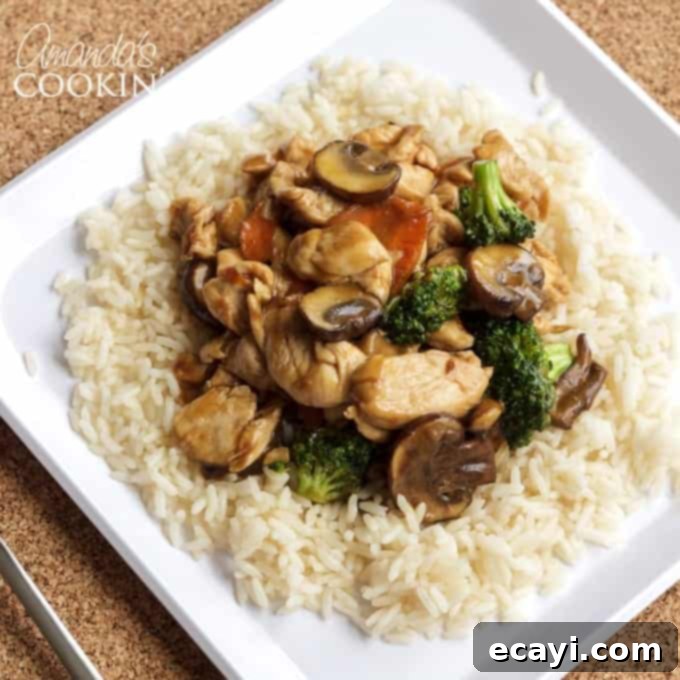Homemade Moo Goo Gai Pan: An Authentic & Easy Chicken and Mushroom Stir-Fry Recipe
Embark on a culinary journey to the heart of Cantonese cuisine with this delightful recipe for Moo Goo Gai Pan. This classic Chinese American dish offers a harmonious blend of tender chicken, earthy mushrooms, and crisp-tender vegetables, all coated in a light, savory, and utterly satisfying sauce. It’s a testament to the art of stir-frying, where fresh ingredients are cooked quickly at high heat to retain their vibrant flavors and textures. While the specific selection of vegetables might vary depending on what’s fresh and available, one ingredient remains consistently at the core of this dish: an abundance of delicious, thinly sliced mushrooms.
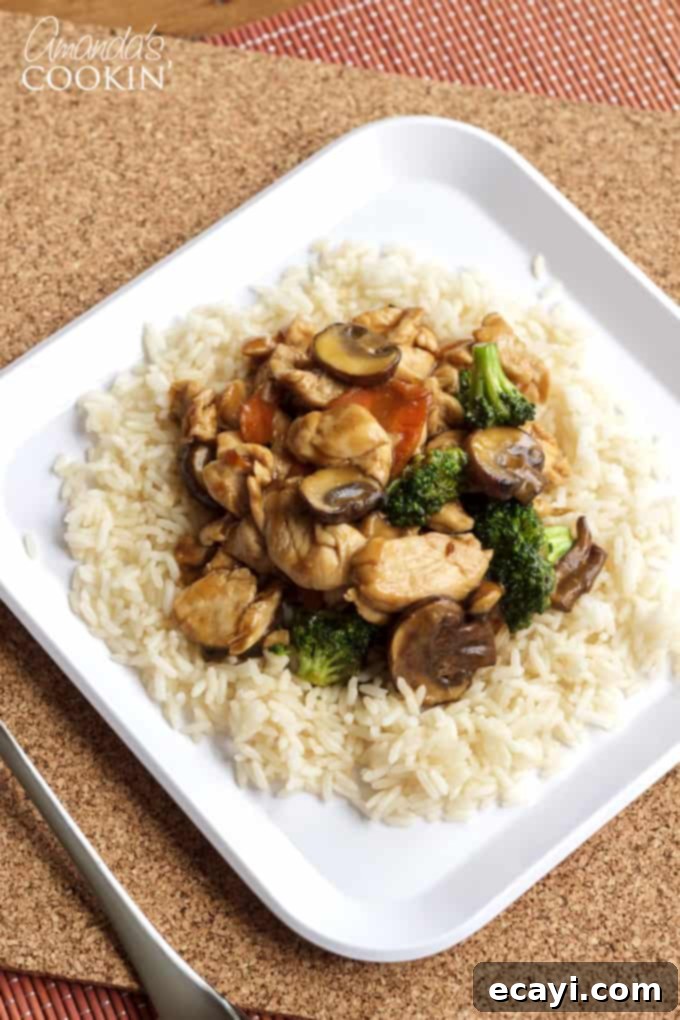
What is Moo Goo Gai Pan? Unpacking This Classic Cantonese Stir-Fry
Moo Goo Gai Pan (often spelled Moogoo Gaii Pan or Mugoo Gai Pan) is a cherished staple in Cantonese-style Chinese cuisine, widely popular in Chinese American restaurants. At its heart, it’s a simple yet elegant stir-fried dish featuring thinly sliced chicken breast, an assortment of fresh mushrooms, and a colorful array of fresh vegetables, all brought together by a light, savory white sauce. Unlike some bolder Chinese dishes, Moo Goo Gai Pan is known for its delicate flavors, allowing the natural essence of the ingredients to shine through. The name itself offers a clue to its primary components: Mohgu translates to “mushroom” in Cantonese, and gai pin means “sliced chicken.” So, literally, it’s “Mushrooms Sliced Chicken” – a wonderfully straightforward description of this iconic dish.
The beauty of Moo Goo Gai Pan lies in its adaptability. While the core chicken and mushroom elements are non-negotiable, the accompanying vegetables offer a canvas for culinary creativity. In the accompanying photos, you’ll see a vibrant mix of carrots and broccoli, which add both color and essential nutrients. However, don’t feel limited! Throughout my cooking adventures, I’ve successfully incorporated a variety of other vegetables, depending on what I have on hand or what’s in season. This includes crunchy bamboo shoots, delicate snow peas, tender pea pods (snap peas), and crisp water chestnuts, each adding its unique texture and subtle flavor. Shaved carrots are a personal favorite for their bright orange hue and quick cooking time, but feel free to experiment with thinly sliced red or yellow bell peppers for an added burst of color and sweetness. The goal is a balanced stir-fry with diverse textures and appealing visuals, making it a feast for both the eyes and the palate.
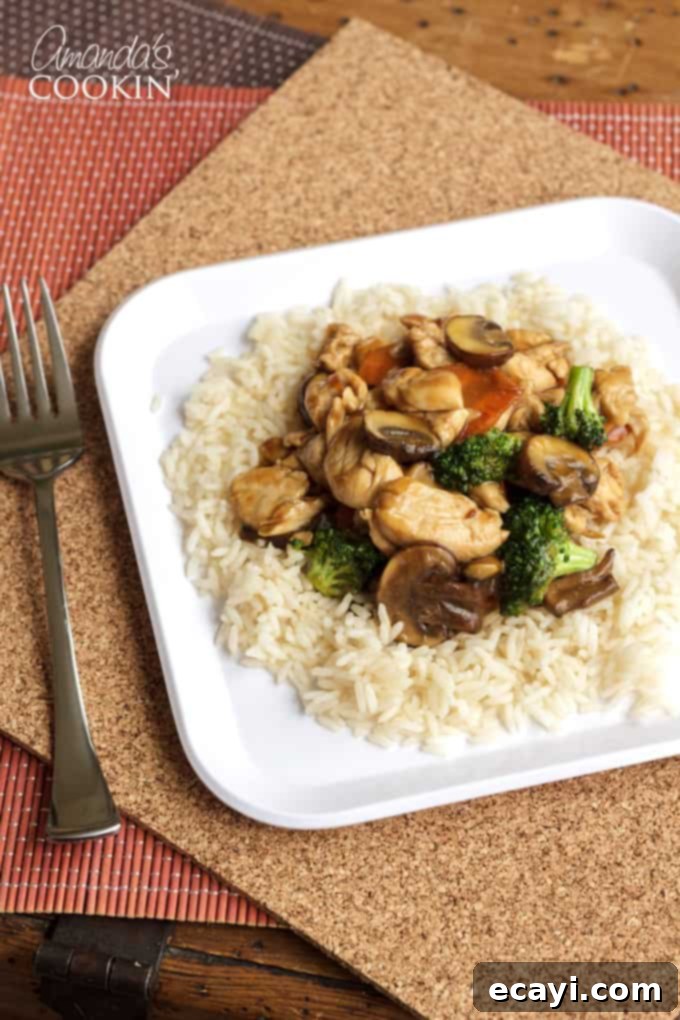
Why Make Moo Goo Gai Pan at Home?
Bringing restaurant-quality Moo Goo Gai Pan into your own kitchen offers numerous advantages. Firstly, you have complete control over the freshness and quality of your ingredients, ensuring a healthier and more flavorful meal. You can adjust the amount of sodium, oil, and sugar to suit your dietary preferences without compromising on taste. Secondly, homemade versions are often more cost-effective than frequent takeout orders, allowing you to enjoy this delicious dish more often. Thirdly, the customization possibilities are endless. Don’t like a certain vegetable? Swap it out! Want extra chicken or more mushrooms? Go for it! This recipe provides a fantastic foundation that you can tailor to your family’s specific tastes and preferences, making it a truly versatile and rewarding dish to prepare.
Essential Ingredients for a Perfect Moo Goo Gai Pan
Crafting this classic stir-fry requires a selection of fresh ingredients and a few pantry staples that contribute to its distinctive Cantonese flavor profile. Here’s a detailed look at what you’ll need and why each component is crucial:
- ½ lb Chicken, sliced thin: Chicken breast is typically used for its lean profile and tender texture when sliced thinly. Thin slicing is key for quick, even cooking in a hot wok. You can also “velvet” the chicken by marinating it briefly in a mixture of cornstarch and a little oil or egg white before cooking; this technique, common in Chinese cooking, locks in moisture and creates an incredibly tender result.
- 1 cup Mushrooms, sliced: As the “Moo Goo” in the name suggests, mushrooms are non-negotiable! Button or cremini mushrooms are classic choices, offering a mild, earthy flavor and meaty texture. For an extra layer of umami, consider adding a few dried shiitake mushrooms (rehydrated and sliced) to the mix. Ensure they are wiped clean and sliced evenly for consistent cooking.
- 1 cup Broccoli florets: Broccoli adds a wonderful crunch, vibrant color, and a boost of nutrients. Cut them into bite-sized florets so they cook quickly and evenly. Other green vegetables like snow peas, snap peas, or asparagus can also be used.
- ¼ cup Chicken broth: This forms the base of our savory sauce, adding depth of flavor without being overly heavy. Low-sodium chicken broth is recommended so you can control the overall saltiness.
- 2 teaspoon Cornstarch: The secret to that beautifully silky, thickened sauce. Cornstarch is essential for creating the desired consistency that coats the chicken and vegetables perfectly. When mixed with liquid, it forms a slurry that thickens rapidly when heated.
- 1 teaspoon Sugar: A touch of sugar helps to balance the savory and umami notes in the sauce, creating a well-rounded flavor profile characteristic of Cantonese cuisine. It’s not meant to make the dish sweet, but rather to enhance and round out other flavors.
- 1 clove Garlic, minced: Garlic provides an aromatic foundation for the stir-fry. Freshly minced garlic is always best for the most potent and delicious flavor.
- 1 tablespoon Rice cooking wine (Shaoxing wine): This is a crucial ingredient for authentic Chinese flavor. Shaoxing wine (or Shaoxing Huadiao wine) adds a complex, slightly nutty, and aromatic depth that cannot be fully replicated. If you don’t have it, dry sherry is often suggested as a substitute, though the flavor won’t be identical.
- 1 tablespoon Hoisin sauce: A thick, fragrant sauce often used in Cantonese cuisine, hoisin sauce adds a wonderful sweet, tangy, and savory element to the dish. It contributes to the rich brown color and robust flavor of the sauce.
- 1 tablespoon Soy sauce: The primary source of saltiness and umami. Use a good quality light (or regular) soy sauce. If you’re managing sodium intake, opt for a low-sodium variety.
Helpful Kitchen Tools: To achieve that perfect stir-fried texture and efficiency, having the right tools on hand makes a big difference:
- Wok or large skillet for stir-frying: A wok is ideal due to its high heat retention and shape, which allows for quick, even cooking and easy tossing of ingredients. If you don’t have a wok, a large, heavy-bottomed skillet or cast-iron pan will work, but ensure it can get very hot.
- Wooden spoon or spatula: Essential for stirring and tossing ingredients in a hot wok without scratching the surface.
- Chef’s knife: For efficient and precise slicing of chicken and vegetables. A sharp knife ensures clean cuts, which is important for even cooking.
- Cutting board: A stable surface for preparing your ingredients safely.
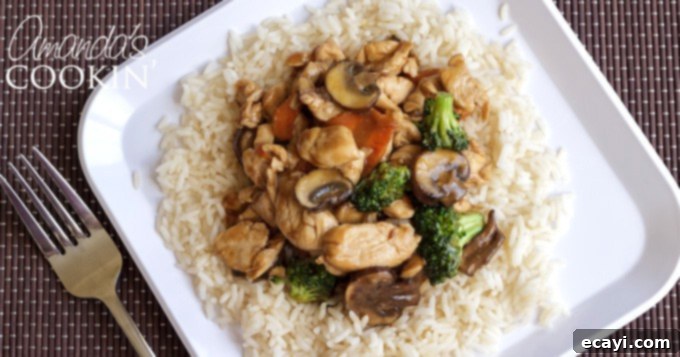
How to Make Moo Goo Gai Pan: A Step-by-Step Guide
Creating this delicious stir-fry is surprisingly straightforward once you have your ingredients prepped. The key to a successful stir-fry is “mise en place” – having all your ingredients measured, chopped, and ready to go before you even turn on the stove. This ensures a smooth and fast cooking process.
- Prepare the Sauce: In a small bowl, whisk together the chicken broth, soy sauce, hoisin sauce, rice cooking wine, cornstarch, and sugar until well combined and no lumps of cornstarch remain. Set this mixture aside; it will be added at the end to thicken the dish.
- Heat the Wok: Place your wok or large skillet over high heat. Allow it to heat thoroughly for about 1-2 minutes. Add a tablespoon of olive oil or another high-smoke-point cooking oil (like peanut or vegetable oil) to the hot wok, swirling to coat the surface. The oil should shimmer, indicating it’s hot enough.
- Stir-fry Vegetables: Add the broccoli florets and sliced carrots (or any harder vegetables like bell peppers) to the hot wok. Stir-fry for 3-4 minutes, or until they are crisp-tender and brightly colored. You want them cooked but still with a slight bite. Remove the cooked vegetables from the wok and set them aside on a plate. This prevents overcooking them while the chicken is prepared.
- Cook the Aromatics and Chicken: Add another tablespoon of oil to the wok, ensuring it’s still on high heat. Add the minced garlic and stir-fry for about one minute until fragrant. Be careful not to burn it. Immediately add the thinly sliced chicken to the wok. Stir-fry the chicken, breaking it apart, until it is no longer pink and is cooked through, usually about 3-5 minutes depending on thickness.
- Combine and Thicken: Give your prepared sauce mixture a quick stir to re-incorporate any settled cornstarch. Pour the broth mixture into the wok with the chicken. Stir continuously as the sauce begins to bubble and thicken, which should take approximately 2 minutes. The sauce will become glossy and coat the chicken.
- Return Vegetables and Serve: Add the previously stir-fried vegetables back into the wok with the chicken and thickened sauce. Cook for another few minutes, stirring gently to ensure all the meat and vegetables are thoroughly coated in the delicious sauce and heated through.
- Serving Suggestion: Serve your homemade Moo Goo Gai Pan immediately over a bed of fluffy white rice, brown rice, or noodles for a complete and satisfying meal.
Understanding the Name: How Do You Say Moo Goo Gai Pan?
For those new to this dish, the name can sometimes be a bit of a tongue-twister. Let’s break it down to make it easier. As mentioned earlier, “Moo Goo” (or Mohgu) literally means “mushroom” in Cantonese, and “Gai Pan” (or Gai Pin) translates to “sliced chicken.”
The pronunciation is generally: Moo-Goo-Guy-Pan. To truly get it right, listening is key. You can listen to the pronunciation here:
Tips for Success and Customization
This recipe, as stated, will generously serve 2-3 people, or possibly 4 if served with ample rice. When I was cooking for a larger family, I would simply double all the ingredients to ensure there was enough for everyone. The beauty of Moo Goo Gai Pan lies in its flexibility. Feel free to use any type of firm, fresh vegetable you like – just remember to cut them into thin, uniform slices or florets so they cook evenly and quickly in the stir-fry. Some excellent additions include baby corn, bok choy, water chestnuts, bamboo shoots, and snap peas. And seriously, don’t skip the mushrooms! They are truly the soul of this dish.
My Love Affair with Mushrooms
My enthusiasm for mushrooms isn’t limited to Moo Goo Gai Pan; I find myself incorporating them into a myriad of dishes these days. Their earthy flavor and satisfying texture are incredibly versatile. Beyond this chicken and mushroom stir-fry, I frequently add them to comfort food classics like a rich, creamy mushroom ravioli or a hearty mushroom stroganoff skillet. In fact, some of the most popular recipes on this very blog are these delectable mozzarella parmesan stuffed mushrooms! My newfound culinary freedom has me eager to explore even more mushroom-centric creations, like savory Mushroom Swiss Burgers and convenient Mushroom Chicken Foil Packets. There’s no end to the delicious possibilities when you embrace these fantastic fungi!
Explore More Irresistible Stir-Fry and Asian-Inspired Dishes
If you’re a fan of the vibrant flavors and quick cooking of stir-fries, you’re in for a treat. After mastering Moo Goo Gai Pan, I highly recommend trying my delicious Mongolian Beef. It’s a fantastic stir-fry recipe that you’ll definitely want to bookmark for future weeknight dinners. Another perennial favorite is this Sesame Chicken recipe – a perfect balance of sweet and tangy chicken, generously sprinkled with toasted sesame seeds and traditionally served over a comforting bed of rice. These dishes, much like Moo Goo Gai Pan, bring the exciting flavors of Asian cuisine right to your dining table with approachable recipes designed for home cooks.
More Related Recipes You’ll Love
For those who enjoy authentic and easy Chinese-inspired dishes, here are more recipes to expand your culinary repertoire:
- Szechuan Beef
- Kung Pao Chicken
- Moo Goo Gai Pan (Don’t forget to save this one!)
- Honey Walnut Shrimp
- Bourbon Chicken
- Beef Lo Mein
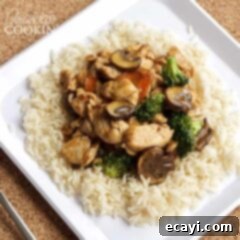
Moo Goo Gai Pan
IMPORTANT – There are often Frequently Asked Questions within the blog post that you may find helpful. Simply scroll back up to read them!
Print It
Rate It
Save ItSaved!
Ingredients
- ½ lb chicken breast sliced thin
- 1 cup fresh mushrooms sliced (cremini or button)
- 1 cup broccoli florets
- ¼ cup low-sodium chicken broth
- 2 tsp cornstarch
- 1 tsp granulated sugar
- 1 clove garlic minced
- 1 tbsp Shaoxing rice wine (or dry sherry)
- 1 tbsp hoisin sauce
- 1 tbsp low-sodium soy sauce
- 1-2 tbsp cooking oil for stir-frying (e.g., olive, peanut, or vegetable oil)
Before You Begin
Instructions
-
In a small bowl, combine chicken broth, soy sauce, hoisin sauce, rice cooking wine, cornstarch and sugar. Whisk thoroughly until smooth and set aside.
-
Heat your wok or large skillet over high heat until smoking. Add 1 tablespoon of olive or other high-smoke-point cooking oil, swirling to coat the surface.
-
Add the broccoli florets and any other hard vegetables (like carrots) to the hot wok. Stir-fry for 3-4 minutes until crisp-tender. Remove vegetables and set aside.
-
Add another tablespoon of oil to the wok if needed, ensuring it remains on high heat.
-
Add the minced garlic and stir-fry for one minute until fragrant. Then, add the thinly sliced chicken.
-
Continue to stir-fry the chicken until it is no longer pink and is fully cooked through.
-
Give the reserved broth mixture another quick stir and pour it into the wok. Let it simmer and thicken a little, stirring constantly, for about 2 minutes. The sauce should become glossy.
-
Return the stir-fried vegetables to the wok. Cook for a few more minutes, stirring to combine the sauce, chicken, and veggies thoroughly and heat everything through.
-
Serve immediately over freshly steamed white rice or your favorite grain.
Frequently Asked Questions About Moo Goo Gai Pan
- What kind of chicken is best for Moo Goo Gai Pan?
- Thinly sliced boneless, skinless chicken breast is traditionally used for Moo Goo Gai Pan. Its lean texture cooks quickly and absorbs the flavors of the sauce beautifully. You can also use chicken thighs for a slightly richer flavor and juicier texture, just be sure to slice them thinly as well.
- Can I make Moo Goo Gai Pan vegetarian?
- Absolutely! To make a delicious vegetarian version, simply substitute the chicken with firm tofu (pressed and cubed or sliced), tempeh, or a plant-based chicken alternative. Ensure to use vegetable broth instead of chicken broth for the sauce.
- What if I don’t have Shaoxing rice wine?
- Shaoxing rice wine adds a unique depth of flavor that is hard to fully replicate. However, if you don’t have it, dry sherry is the best common substitute. White wine vinegar or rice vinegar could work in a pinch for acidity, but they won’t offer the same nuanced flavor profile.
- How can I make my Moo Goo Gai Pan spicier?
- Moo Goo Gai Pan is typically a mild dish, but you can easily add heat. Incorporate a pinch of red pepper flakes with the garlic, add a dash of chili oil to the sauce, or serve with sriracha on the side.
- Can I use frozen vegetables?
- Yes, you can use frozen stir-fry vegetable mixes for convenience. Thaw them thoroughly before adding to the wok and drain any excess water to prevent making the dish watery. Adjust cooking times as frozen vegetables may cook faster.
- How do I prevent my stir-fry from getting soggy?
- Several factors contribute to a crisp stir-fry: 1) Use a very hot wok/skillet. 2) Don’t overcrowd the pan – cook ingredients in batches if necessary. 3) Ensure vegetables are dry before adding to the oil. 4) Cook vegetables until crisp-tender, then remove them before cooking the chicken, adding them back only at the very end.
- Can I prepare parts of the Moo Goo Gai Pan ahead of time?
- Yes, “mise en place” is your friend here. You can slice the chicken and vegetables a day in advance and store them separately in airtight containers in the refrigerator. The sauce mixture can also be prepared ahead and stored in the fridge. This makes the actual stir-frying process incredibly fast on a busy weeknight.
Nutrition
The recipes on this blog are tested with a conventional gas oven and gas stovetop. It’s important to note that some ovens, especially as they age, can cook and bake inconsistently. Using an inexpensive oven thermometer can assure you that your oven is truly heating to the proper temperature. If you use a toaster oven or countertop oven, please keep in mind that they may not distribute heat the same as a conventional full sized oven and you may need to adjust your cooking/baking times. In the case of recipes made with a pressure cooker, air fryer, slow cooker, or other appliance, a link to the appliances we use is listed within each respective recipe. For baking recipes where measurements are given by weight, please note that results may not be the same if cups are used instead, and we can’t guarantee success with that method.
This post was originally published on: Mar 1, 2009

